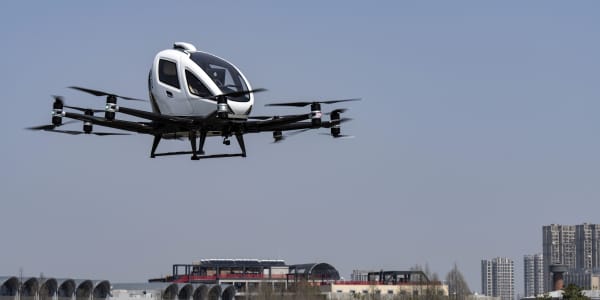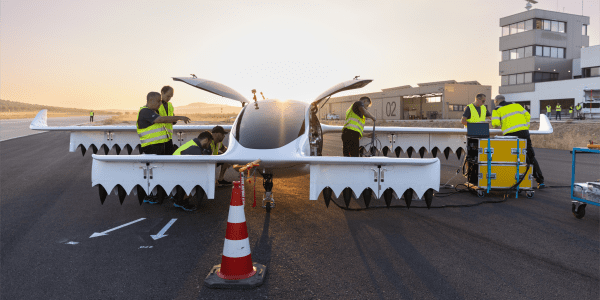Television has a few trappings we don't usually think too much about.
Viewers can see things on screen from the angle the camera offers, but no other. Sure, camera technology has improved and more lenses are incorporated into everything from films to sporting events, and it seems like the vantage point from our couch is improving. In actuality, though, it's a subtle step at best.
A paradigm shift might be on the way, though, if Intel Studios' vision comes true. The Los Angeles-based state-of-the-art production studio, which opened in January, is dedicated to the production of virtual and augmented reality. At the center of its 25,000-square-foot space is a 10,000-square-foot dome designed to capture actors, players and objects in volumetric 3-D, letting viewers see things from a near infinite number of angles.
There's been plenty of pie-in-the sky dreaming about immersive media for years, but Intel's technology, called True View, is already gaining attention — from Paramount, one of Hollywood’s biggest film studios. Paramount recently partnered with Intel to explore True View's potential in its various entertainment mediums. So far, Paramount has not announced or revealed any projects with Intel; the priority now is to let directors and content creators become familiar with what True View can do and begin to imagine use cases.
Intel is also partnering with John Brenkus, a six-time Emmy award winner and the creator/host of “Sport Science” on ESPN, to create volumetric sports content for his new show, called "Soul and Science."
"If you look at our past successes ... it has been very successful traditional, linear content," said Brenkus. "What it hasn't been able to do is deliver content in a way that people not only haven't seen but haven't imagined. The partnership with Intel is the perfect partnership to [give] an audience an insight on the world greatest athletes through a lens they've never even imagined."
Intel Studios is hoping its next-generation VR and AR will go beyond producers of scripted content to attract ad agencies and producers of live sporting and music events.
Live action through a new lens
With True View, multiple cameras with multiple lenses offer a 360-degree view of a scene or event. Viewers can then choose the camera position and angle they want — and zoom in on a moment at will. Think, as an example, of computer-generated graphics. CGI artists have been able to zoom in and out from any direction they pleased for some time. With volumetric 3-D, Intel is making it possible with live action.
More from The Edge:
Smartphone-controlled, color-changing fabric is coming to your clothes and furniture
These humanoid robots will make you question reality
While it can be adapted for traditional television, volumetric 3-D really shines in virtual reality and augmented reality headsets. Since those fields are changing so rapidly, Intel is centering its efforts on the big data component, figuring out how to best process the data. And there's a lot of it.
Shooting just one minute of an NFL game, True View gathers 3TB (terabytes) of data. In just 15 minutes that works out to the data equivalent of all of the text in the Library of Congress.
"We have 10 petrabytes of storage on premises [10,000 terabytes]," said Howard Wright, vice president of global business development for Intel Sports.
Compiling that and letting users access it without delay will still take some time — and Intel won't say exactly how long. But the goal, said Wright, is to make it instantaneous.
We want to show our partners, from commissioners to billionaire owners, that we're building the stadiums of the future and arenas of the future and we've orchestrated the violent collisions of ones and zeros in this stadium.Howard Wrightvice president of global business development for Intel Sports
"Our goal is to get to a real-time experience," he said. "You would have, say, a second screen experience [in a stadium] and ... you would be able to see in real time what [your favorite athletes] are seeing as they are seeing it. This is how we're trying to use a lot of Intel's technical muscle to race to that reality and build this new digitized and personalized world. ... We have a hyper-aggressive timeline, and our CEO has wagged his finger at us [to achieve it]."
Teaming up with sports franchises
That will require the partnership of sports franchises, and Intel's just at the beginning of that process. At least 38 5K cameras and ample storage space will need to be installed in stadiums to let True View work, to create the cloud of data the technology can pull from. And Intel's hoping the partnership with Brenkus starts the ball rolling with sports leagues.
"We want to show our partners, from commissioners to billionaire owners, that we're building the stadiums of the future and arenas of the future and we've orchestrated the violent collisions of ones and zeros in this stadium," said Wright. "We're envisioning a world where we're going to create infinitely more content."
Analysts say there's certainly potential to True View, but caution it has a long way to go before it's something that could hope to reshape the entertainment world.
"It's a little bit early. There are a lot of interesting use cases for the technology, and Intel has historically worked with others," said Rubin Roy, an analyst at MKM Partners. "What it comes down to is when are the various sports entities, whether it's the NFL or NBA, going to be able to broadcast actual content to users using this technology. ... It's an interesting technology, but I don't think it's a game changer."
Nevertheless, Wright is optimistic. "We're hoping to blaze a trail, as we've done in other verticals throughout the history of Intel," he said. "In this new vertical, though, we need co-travelers and co-architects."
The advantage for those companies willing to take the leap of faith? Should this technology become as popular as Intel believes it will, content creators like Brenkus will have a head start over their competition.





